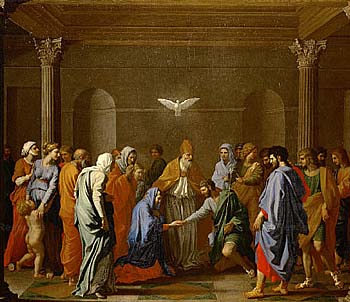This Sunday, June 10, 2012 will be a special day at Trinity Church, for on this day, married couples will be invited to step forward (or at least, stand together) to renew the vows they made to one another before God on the day they were married.
Perhaps to truly understand the wondrous beauty of a marriage, it would behoove one to examine the various definitions and interpretations of sacrament and matrimony. The American Heritage Dictionary defines sacrament (as used for our meaning here) as a ceremony to confer sanctifying grace. The Orthodox traditions don't even bother trying to define sacrament, having decided that a definition is too complicated and leaves it at "it's a sacred mystery." The Roman Catholic Church defines a sacrament as "an efficacious sign of grace, instituted by Christ and entrusted to the Church by which divine life is dispensed to us." Those of us who grew up in the Episcopal tradition have learned that a sacrament is "an outward and visible sign of an inward and spiritual grace given by Christ as a sure and certain means by which we receive that grace." You begin to see why the Orthodox traditions went the "easy" way. The Roman Catholic definition and the Episcopal definition are not that far removed from one another (the RC definition safeguards the power of the institution of the Church).
Matrimony is the legal or religious term used in reference to marriage. The word stems from Latin roots mater meaning "mother" and the Latin suffix -monium referring to an "action, state or condition." An Old French word seems to be the basis of our modern English word: matremoine. The word defines the condition required of being a mother. In that culture, motherhood was legitimized only within the state of marriage. (Interestingly, the similarly rooted word patrimony refers to estate or property that is inherited from the father. Quite a contrast in sense implication. Where matrimony implies a sense of binding-uniting in marriage, patrimony implies a sense of unbinding-distribution of estate through inheritance).

The beauty lies in the sacred mystery. That God, being invited to be a part of this memorable moment in a couple's life together, transforms that union with divine grace. Certain Christian faiths refer to the sacrament of Holy Matrimony as a "lay sacrament" because the vows exchanged by the couple are the vehicle by which the grace of God is conferred, and the priest merely acts as witness to the sacrament. This 17th century painting by Nicholas Poussin The Sacrament of Holy Matrimony depicts the couple's exchange being unified and sanctified by the Holy Spirit. (Note the rays emanating from the dove to embrace the couple.)
The Episcopal Church believes and teaches the two great sacraments: Holy Baptism and Holy Eucharist. But our faith also recognizes other sacramental rites as important moments or markers along our journey of faith, including the sacrament of Holy Matrimony. In the catechism (which can be found toward the end of The Book of Common Prayer), Holy Matrimony is described as a rite in which a couple enters into a life-long union before God and the church. What makes this a "sacrament" rather than just a celebration is the gift of grace from God to help the couple fulfill the vows they made. So really, the vows are not made just between the couple, but also between the couple God. Thus, those who are bound to one another and God through Holy Matrimony shall no one "put asunder."
No comments:
Post a Comment